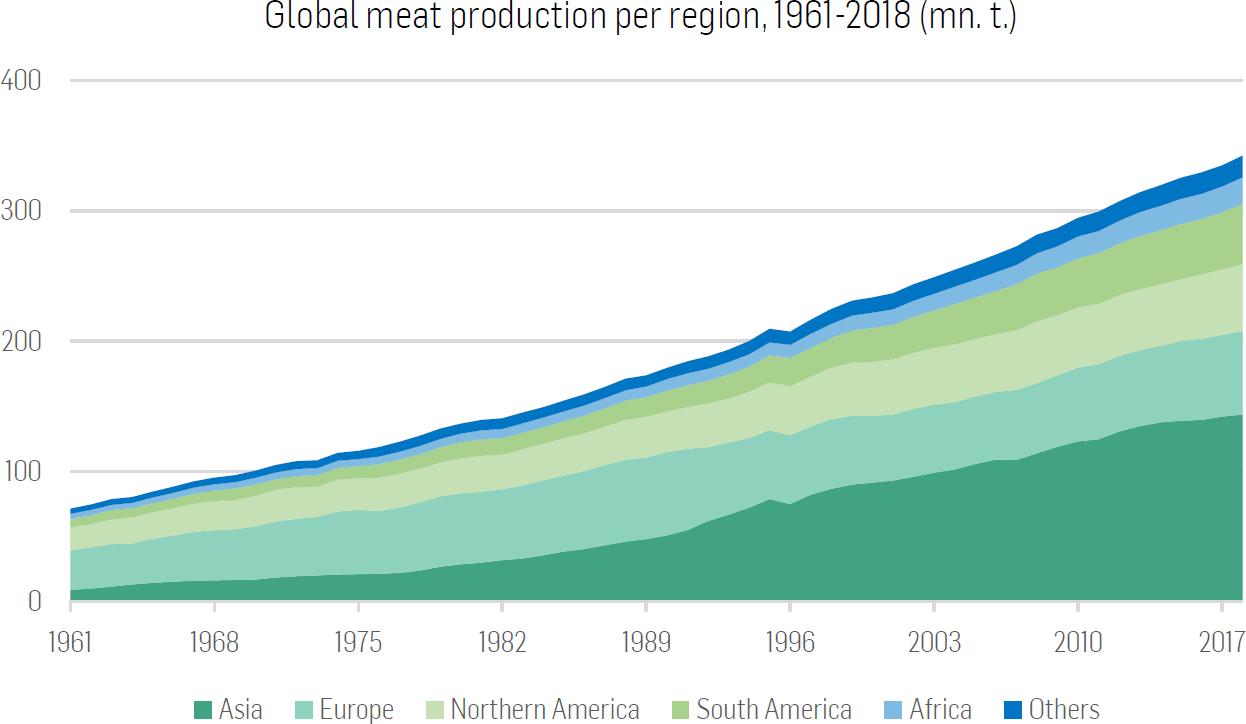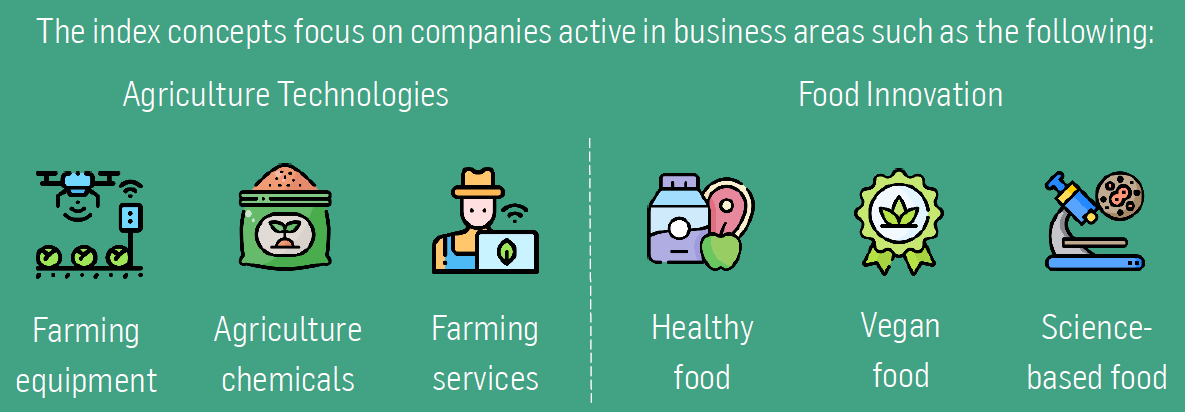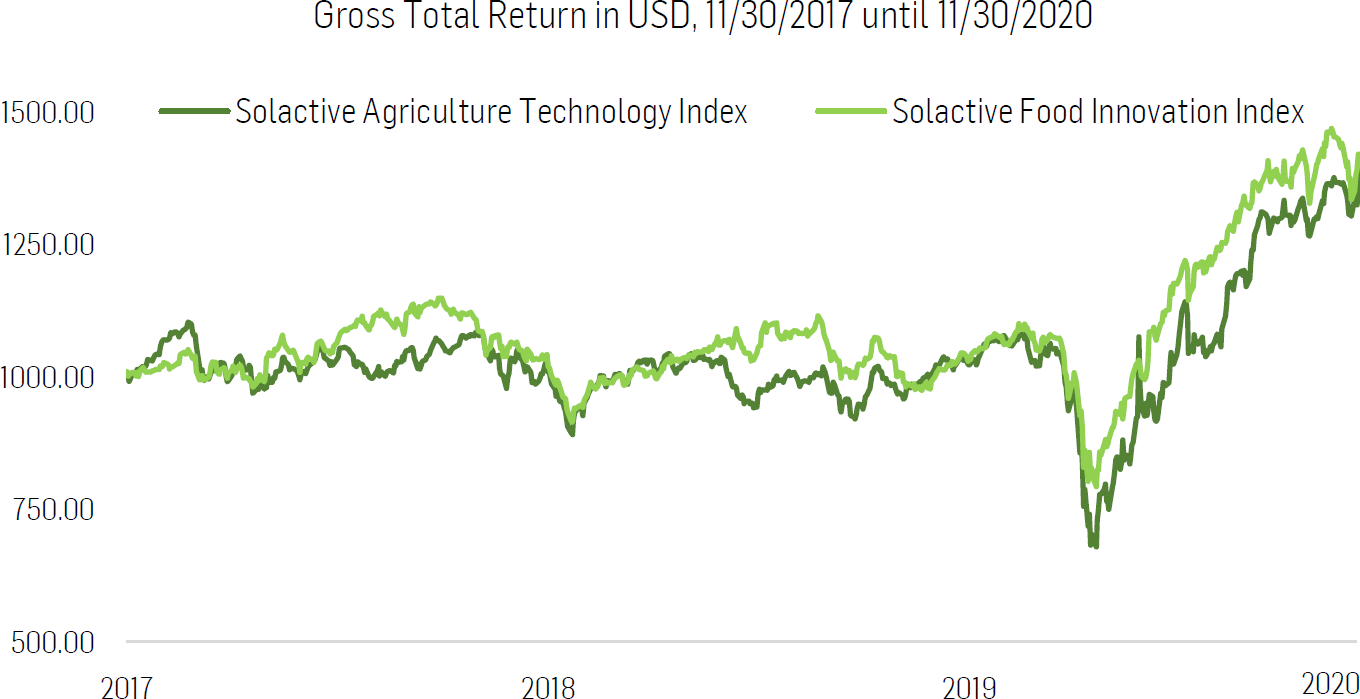Don’t Bite the Hand that Feeds Us: Solactive Agriculture Technology and Solactive Food Innovation Index Concepts
|
Invest in advancements within the agriculture and food industries with the Solactive Agriculture Technology and Solactive Food Innovation Index Concepts, and support companies that stand for sustainability and innovation in some of the oldest economic sectors. The concepts provide an opportunity for investors to benefit from transformations in the food supply chain, particularly in farms and food manufacturers. The index constituents are taking advantage of the latest technologies in farming and food production, which are crucial for the achievement of Zero Hunger – the second Sustainable Development Goal adopted by United Nations Member States. |
Food Industry as One of the Key Economic Segments
Food is vital for humankind: it provides people with nutrients and energy, while food traditions bring joy and the feeling of togetherness. An average person in the United States spends around 20 days per year either eating or drinking, and ten more days on food preparation and clean-up.1 Not surprisingly, the food sector has become one of the key global industries, accounting for around 10% of GDP worldwide.2 Nevertheless, there are several negative aspects of the current nutrition system: economic losses from insufficient food safety, greenhouse gas emissions, two billion people being under- and malnourished, whilst two billion people are overweight and obese, among others. On this negative side, the World Bank states that the global food system leads to costs of around 7% of global annual GDP.2 While manufacturing food, humans are biting the hand that feeds humankind – thereby also revealing inefficiencies of the traditional food industry. The economic costs of 7% of GDP appear quite high in comparison to 10% GDP that is contributed through the food industry. This disparity – the hard-to-quantify costs including all negative externalities of the food industry on the one hand and its contribution to the global GDP on the other hand – urges an adaptation to the following trends: population growth, climate change, and a shift in demand towards healthier nutrition. Addressing these challenges is a significant step towards sustainable economic growth and prosperity, since it contributes to the establishment of an efficient food industry, which provides enough nutrition to the global population. This, in turn, is decisive for the achievement of Zero Hunger – the second Sustainable Development Goal, adopted in 2015 by the United Nations Member States.
Contemporary Challenges in the Food Industry
Providing food involves manifold challenges. First, due to a constantly increasing population, global food supply chains will face the challenge of nourishing 10 billion people by the year 2050, under the constraints of limited land resources. Currently, about 10% of the global population goes hungry, and to satisfy the rising needs of the population, the industry has to either expand production, significantly enhance production efficiency, or both.3
Second, the food industry is dealing with the challenge of how to minimize greenhouse gas emissions. Nowadays, it accounts for more than a quarter of emissions worldwide, among which farms contribute more than 60% of total emissions related to food.4 To decrease this number, better farm management solutions, as well as crop protection and yield management, are needed.
Finally, the emerging trend of health awareness incentivizes the food industry to shift towards healthier products, including protein alternatives and plant-based food. According to studies conducted in the United States, meats, dairy, and sweeteners contribute to a lower share of calories than what they used to in 1970.5 Changes in diet require the food industry to enhance the safety of its products and to consider science-based approaches.
Key Developments in the Food Supply Chain to Address Challenges
There are several initiatives to tackle challenges along the whole food value chain, but we would like to focus on the drastic advances in agriculture and in food production, since those add the largest value to this value chain: agriculture alone contributes around 40%.2 To address the aforementioned challenges, a new approach to farming is needed. The smart agriculture market segment is still emerging and accounts for less than 1% of the global agriculture market.6 However, growth rates are promising: the market size of the smart agriculture industry is expected to grow at a CAGR of 9.8% over the period spanning from 2020 to 2025 (from USD 13.7bn to USD 22bn).6 This progress makes the following busines areas more and more attractive to investors:
- Advanced farming equipment (machine control, steering, and wireless connectivity, among others);
- Chemicals (crop protection, plant nutrition, and yield optimization solutions, among others);
- Services (supply chain optimization, precision agriculture advisory, and big data solutions implementation, among others).
In the food market, innovative products also have the advantage of higher growth rates if compared to conventional ones. For example, the global meat production demonstrated a CAGR of 2% over the period between 2008 and 2018.7 Projected growth rates in this segment are by far not likely to reach the level of the plant-based meat segment, which is expected to expand at a CAGR of 18% over the period spanning from 2020 to 2025.8

Source: Our World in Data, global meat production.7
Plant-based meat is not the only example of innovation that has perspectives of high growth. Promising innovations in the market fall under the following business areas as well:
- Healthy nutrition (protein meals, healthy snacks, organic ingredients);
- Vegan food (plant-based protein, ready-to-cook solutions);
- Science-based nutrition solutions (dietary supplement, flavorings).
Solactive Agriculture Technology and Solactive Food Innovation Index Concepts
To contribute to tackling the challenges that the global food industry faces, as well as to provide investors exposure to growing industries, we have constructed the Solactive Agriculture Technology and Solactive Food Innovation Index Concepts. The indices are designed to benefit from companies that are actively participating in either the improvement of farming processes or in innovative nutrition solutions. Both can be customized as stand-alone indices, or combined in an index covering developments in the whole food value chain.

The Solactive Agriculture Technology Index Concept is based on a global universe of common shares with an average daily trading volume of at least USD 1mn over the last month before selection and a market capitalization of at least USD 100mn. Certain markets are excluded due to accessibility. Among the set of global companies, the ones that are most relevant to the respective themes have been selected using Solactive’s proprietary natural language processing (NLP) tool ARTIS® (Algorithmic Theme Identification System). Companies with a significant thematic exposure to the agriculture industry and keywords such as “high-tech farming”, “agricultural technologies”, “precision agriculture”, and many more, are considered relevant. In addition, to be eligible for the index, companies should operate in one of 23 eligible FactSet Industries: “Chemicals: Agricultural”, “Trucks/ Construction/ Farm Machinery”, “Miscellaneous Manufacturing”, “Agricultural Commodities/Milling”, among others. All eligible industries cover the following FactSet economic sectors: “Producer Manufacturing”, “Electronic Technology”, “Process Industries”, “Consumer Non-Durables”, “Health Technology”, and “Technology Services”. The resulting index of the most relevant 30 companies selected in November 2020 demonstrated an average annualized return of 14.7%, and a volatility of 17.8%, over a three-years-period ending in November 2020.
The Solactive Food Innovation Index Concept is based on the same starting universe – a global universe of common shares with an average daily trading volume of at least USD 1mn over one month prior to the selection date and a market capitalization of at least USD 100mn, while certain markets are excluded due to accessibility. In this universe, the NLP-tool ARTIS® selects companies based on keywords such as “plant-based protein”, “nutritional innovation”, “natural ingredient solutions”, alongside many more. Companies associated with unhealthy food (e.g. producing sweet food, candy, soda and sugar drinks, unhealthy fast food, and alike), as determined by ARTIS®, are screened out. The top-30 most theme-relevant companies comprise the overall index, which demonstrated an average annualized return of 14.2% and volatility of 24.3% over the back casted three-years-period ending in November 2020.
Solactive Agriculture Technology and Solactive Food Innovation Indices 3Y Performance


Final Remarks
The food industry has always naturally been vital for humankind. However, the economic burdens and negative externalities that it causes are troublesome, and thus drastic changes towards sustainability appear necessary. Due to the increasing demand from an expanding population, the necessity to reduce greenhouse gas emissions, and a shift in the population’s nutrition preferences, companies that implement innovations in agriculture and food manufacturing will have a solid base to grow in the near future. Early adopters likely have a competitive advantage. The Solactive Agriculture Technologies and Solactive Food Innovation Index Concepts provide exposure to leading companies positioned along the food value chain, and help investors to benefit from technological progress in century-old industries.
References
[1] U. S. Bureau of Labor Statistics (2020); American Time Use Survey. Table 12, Average hours per day spent in primary activities for the civilian population, 2019 quarterly and annual averages. https://www.bls.gov/news.release/atus.t12.htm
[2] World Bank Blogs (2019); Do the costs of the global food system outweigh its monetary value?
https://blogs.worldbank.org/voices/do-costs-global-food-system-outweigh-its-monetary-value#:~:text=Since%20the%20post%2Dfarm%20to,the%20%2480%20trillion%20global%20economy
[3] World Resources Institute (2018); How to Sustainably Feed 10 Billion People by 2050, in 21 Charts. https://www.wri.org/blog/2018/12/how-sustainably-feed-10-billion-people-2050-21-charts
[4] American Association for the Advancement of Science (2018); Reducing food’s environmental impacts through producers and consumers. https://science.sciencemag.org/content/360/6392/987
[5] Pew Research Center (2016); What’s on your table? How America’s diet has changed over the decades
https://www.pewresearch.org/fact-tank/2016/12/13/whats-on-your-table-how-americas-diet-has-changed-over-the-decades/
[6] Markets and Markets (2020); Smart Agriculture Market. https://www.marketsandmarkets.com/PressReleases/smart-agriculture.asp
[7] Our World in Data. Global meat production.
https://ourworldindata.org/meat-production#global-meat-production
[8] Arizton (2020); Plant-based Meat Market – Global Outlook and Forecast 2020-2025
https://www.reportlinker.com/p05955544/Plant-based-Meat-Market-Global-Outlook-and-Forecast.html?utm_source=PRN
Dr. Axel Haus, Team Head Qualitative Research
Solactive AG
